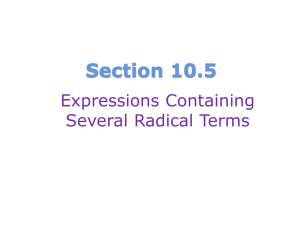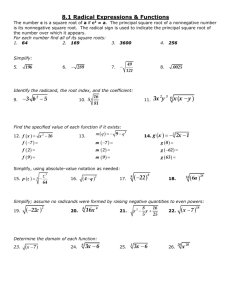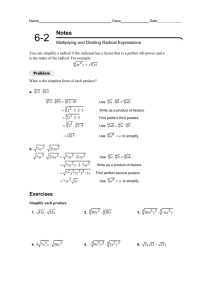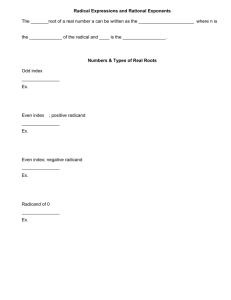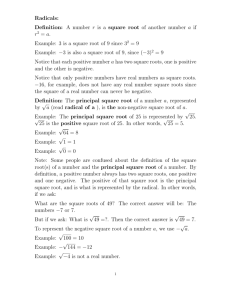Nth Roots of an expression
advertisement
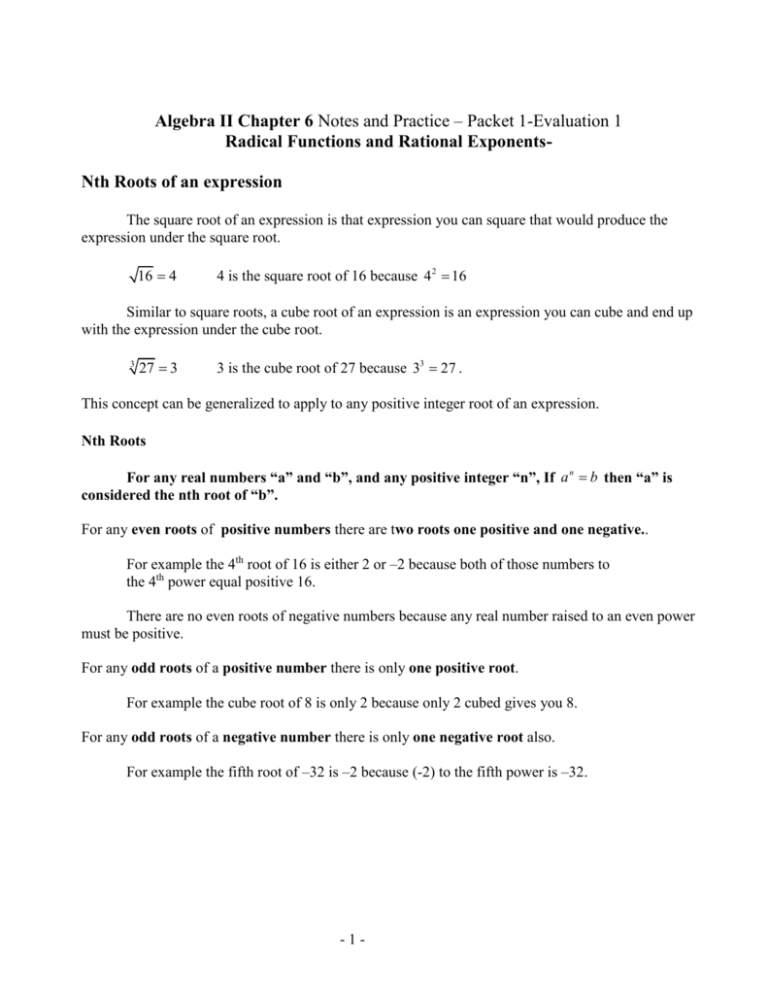
Algebra II Chapter 6 Notes and Practice – Packet 1-Evaluation 1 Radical Functions and Rational ExponentsNth Roots of an expression The square root of an expression is that expression you can square that would produce the expression under the square root. 16 4 4 is the square root of 16 because 4 2 16 Similar to square roots, a cube root of an expression is an expression you can cube and end up with the expression under the cube root. 3 27 3 3 is the cube root of 27 because 33 27 . This concept can be generalized to apply to any positive integer root of an expression. Nth Roots For any real numbers “a” and “b”, and any positive integer “n”, If a n b then “a” is considered the nth root of “b”. For any even roots of positive numbers there are two roots one positive and one negative.. For example the 4th root of 16 is either 2 or –2 because both of those numbers to the 4th power equal positive 16. There are no even roots of negative numbers because any real number raised to an even power must be positive. For any odd roots of a positive number there is only one positive root. For example the cube root of 8 is only 2 because only 2 cubed gives you 8. For any odd roots of a negative number there is only one negative root also. For example the fifth root of –32 is –2 because (-2) to the fifth power is –32. -1- Radical Notation Radical notation in math is any positive integer root of a real number written in the form n a b n is the root (index) of “a”(radicand) such that a n b (principle root) Example 4 16 2 2 is said to be the principle 4th root of 16. - 4 16 2 Nth roots of a n , a 0 For any negative real number a, n a n a when n is even Simplifying Radical expressions Examples Simplify the following radical expressions Example 1 4 16 x8 4 24 ( x 4 ) 2 2 x 2 Note: since x 2 can never be negative absolute value symbols are not needed around the x 2 in the answer. 9 x 6 32 ( x3 )2 3 x3 Note: since the square root of x 6 x3 and it is possible for x 3 to be a negative number, absolute value symbols are necessary. NOTE: ANY TIME YOU TAKE THE EVEN ROOT OF A VARIABLE RAISED TO AN EVEN POWER AND THE RESULT LEAVES YOU WITH AN ODD EXPONENT, ABSOLUTE VALUE SYMBOLS ARE NEEDED. -2- Practice Problems Simplify each of the given Radical Expressions. If absolute value symbols are needed make sure you use them. Find only real roots. 1. 81 5. 16x 2 y 2 2. 25 3. 4 16 x 8 y18 6. 4. 7. 3 3 27 27 y 6 Multiplying and Dividing Radical Expressions Radical expressions can be multiplied or divided as long as the index of each root is the same. Multiplication of nth roots If n a and n b are real numbers then n a n b n ab Examples Simplify the following Products if possible Ex: 1 18 2 36 6 3 3x5 3 9 y 4 3 27 x5 y 4 3xy 3 x 2 y Ex: 2 -3- Ex: 3 8 2 16 4 4 2 Ex: 4 8 Not a real number Practice Problems Simplify the given products if possible 1. 3 12 2. 3 4x3 3 16x7 Dividing Radical Expressions 3. 5 5 4. 3 x3 3 y 5 If two radical expressions with the same index are being divided, you can rewrite the division as a single radical expression with the quotient on the inside of the radical with the given index. n n a na for b 0. b b Examples of Division of radicals (Assume all variables are positive) 8 8 42 2 2 Ex: 1 Ex: 3 4 28 x7 4 14 x 2 4 Ex: 2 16 x3 16 x3 4x2 2x 4 x 4x 28 x7 4 5 2x x 4 2x 2 14 x Rationalizing the Denominator Sometimes when you divide radical expressions you are left with a radical expression in the denominator of the fraction or you are left with a denominator inside of a radical. Neither case is desirable in an expression. So to eliminate this problem you will need to do a process called rationalizing a denominator. Examples of rationalizing the denominator are shown below. Examples: Rationalize the denominator of each expression. Assume that all variables are positive. Ex: To rationalize a square root in a denominator multiply the top and bottom of the fraction by the denominator After you simplify the fraction. -4- 5 3 Method 1. Ex: 3 5 3 3 3 5 x3 5 5 4 2x 2x 2x Method 1. Ex 2 2x 10 x 2x 2x Rationalizing a denominator that is an “nth root” requires you to multiply the numerator and denominator by something that makes the denominator a perfect “nth root”. Method 2 (Rationalizing nth roots) 3 x4 x4 x3 3 3 3 5 xy 5 xy 5y Ex: 3 4 Ex: 4 4 6 x3 y 6 x3 y 2 x5 y 2 2 x5 y 2 4 4 52 y 2 3 25 x3 y 2 x 3 25 y 2 3 3 3 52 y 2 5y 5 y 3 x2 y 4 x2 y3 4 x2 y3 4 4 3x 2 y 3 x4 y 4 3x 2 y 3 xy 4 Practice Problems - Divide the following radical expressions. If necessary rationalize the denominator. 81 3 3 3 1. 3 4. 3 5 x3 15 x 2 2. 5. 56 x 5 y 5 7 xy 5 3 2x -5- 3. 4 16 x 7 y 5 4 x3 y 5 16 x5 y 2 5 4 x6 y8 6. -6-

